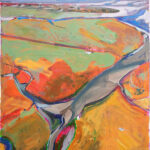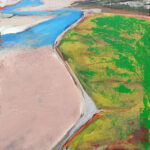No products in the cart.

Stefaan Vermeulen
Landmarks
Saturday 05/08/2023 — Sunday 03/09/2023
Opening Sunday 06/08/2023 at 16.00
Introduction: Kristof Reulens, author and coordinator ‘Heritage and Arts’ of the City of Genk
Curator: Daniela Chirion
Born on Oct 6th, 1966 in Hasselt, Belgium, Stefaan Vermeulen grew up in Genk, a provincial mining town and melting pot of more than 60 nationalities. His master studies in art from Hugo Duchateau and Ado Hamelrijck influenced him to develop a preference for natural materials, human scale installations and a deep interest in contemporary pur-sang painting. Although one might find a layer of humour in some of his works, his drawings and paintings often show a sour and slightly melancholic view on the reality that surrounds him. Stefaan Vermeulen is studying the boundaries and meanings in today’s way of depiction. He lives and works near Roman town Tongeren.
As a neo-impressionist, Vermeulen has worked in recent years on a wide range of large and small landscapes. He bases himself loosely on photographic material to create a poetic, semi-realistic representation in many layers of transparent acrylic on canvas or panel. In this way the subject becomes subordinate to light and colour, both of which are rendered with seemingly reckless and rough brushstrokes. His focus in recent years on painting landscapes is not a flight from reality, his work belongs in our time. It invites the viewer to look at the world in a different way, not from a nostalgic reflex but more caringly and slowly, with more consultation and reflection. How can we cherish without being conservative?
Unlike many painters who work in acrylics, Vermeulen does not use this medium in a thick pasty manner, instead he combines multiple, very thin layers (may be up to 20 layers sometimes) of paint. One could compare it to a way of painting that is more often used in watercolour, thus creating complex colour shades, transparencies and depth. Combined with a fairly ‘bold’ brush stroke, this results in a lot of details that almost occurs accidentally. He tries to create a painting that is in a way very true to nature, as in real life, where there’s also a lot of coincidence in how structures as well as details are created.
“In recent years I have mainly been working as a landscape painter, a choice that has gone a bit by itself since I have lived in Haspengouw, which is like Belgian Tuscany. I don't paint landscapes from a romantic approach, I rather ask myself the question 'how' I want to depict something.
The reality that I see around me often seems inexplicably poetic to me. Maybe that is the eye of the artist, who does not look practically or problematically, but who is simply interested in the appearance of reality. It is in the translation into strokes of paint that I want to repeat that experience for the viewer, without using the original story I saw. So the final painting is not just an image of a landscape, it should autonomously replace the original image (which only I saw). Subject or place are therefore not important, but the texture on the canvas, the strokes of paint and that part of my actions that is visible to the viewer.
What is special about this is that the result is figurative. I actually use the means of an abstract painter (who leaves a lot to the paint and to chance) to get a figurative result in the end.”
Stefaan Vermeulen werd op 6 oktober 1966 geboren in Hasselt, maar groeide op in Genk. Aan de hogeschool in Genk kreeg hij les van Hugo Duchateau en Ado Hamelrijck, die beiden van grote invloed zijn geweest op zijn later werk als schilder en beeldend kunstenaar.
Hoewel soms met humor gelaagd, spreekt uit zijn tekeningen en schilderijen ook een wrange en wat melancholische blik op de werkelijkheid. In zijn oeuvre zoekt Stefaan Vermeulen naar de grenzen en de betekenis van hedendaagse manieren van afbeelden. Hij woont en werkt in Vliermaal (nabij Tongeren).
Als neo-impressionist werkte Stefaan Vermeulen de voorbije jaren aan een uitgebreide reeks grote en kleinere landschappen. Hij baseert zich daarbij losweg op fotomateriaal om in vele lagen transparant acryl op doek of paneel een poëtische, semi-realistische weergave te creëren. Zo wordt het onderwerp ondergeschikt aan licht en kleur, die beiden met schijnbaar onbezonnen en ruwe verfstreken worden neergezet. De focus die Vermeulen de laatste jaren legt op het schilderen van landschappen is geen vlucht uit de realiteit, zijn werk hoort thuis in onze tijd. Het nodigt de toeschouwer uit om anders naar de wereld te kijken, niet vanuit een nostalgische reflex maar zorgzamer en trager, met meer overleg en reflectie. Hoe kunnen we koesteren zonder behoudsgezind te zijn?
In tegenstelling tot veel schilders die met acrylverf werken, gebruikt Vermeulen dit medium niet op een dikke pasteuze manier, maar combineert hij meerdere, zeer dunne lagen (soms wel 20 lagen) verf. Je zou het kunnen vergelijken met een manier van schilderen die vaker wordt toegepast bij aquarel, waardoor complexe kleurschakeringen, transparanties en diepte ontstaan. In combinatie met een vrij 'gewaagde' penseelstreek resulteert dit in veel details die bijna toevallig ontstaan. Hij probeert een schilderij te maken dat op een bepaalde manier heel natuurgetrouw is, zoals in het echte leven, waarbij er ook veel toeval is in hoe structuren en details ontstaan.
“Dat ik de laatste jaren vooral aan het werk ben geweest als landschapsschilder, is een keuze die een beetje als vanzelf is gegaan sinds ik in Haspengouw woon. Dat schilderen van landschappen doe ik niet vanuit een romantische benadering, ik stel me veel meer de vraag ‘hoe’ ik iets wil afbeelden.
De werkelijkheid die ik rondom mij zie, doet zich naar mijn gevoel vaak onverklaarbaar poëtisch voor. Misschien is dat het oog van de kunstenaar, die niet praktisch of problematisch kijkt, maar die gewoon geïnteresseerd is in de verschijning van de werkelijkheid. Het is in de vertaling naar verfstreken dat ik die ervaring voor de kijker wil herhalen, zonder gebruik te maken van het oorspronkelijk verhaal dat ik zag. Het uiteindelijke schilderij is dus niet gewoon een afbeelding van een landschap, het zou autonoom het oorspronkelijke beeld (dat alleen ik dus gezien heb) moeten vervangen. Onderwerp of plaats zijn nauwelijks van belang, wel de textuur op het doek, de verfstreken, de manier van schilderen en van uitbeelden, het evenwicht tussen wat ik wel en niet afbeeld, en tussen datgene wat ik controleer en datgene wat ik niet controleer en dat deel van mijn acties dat zichtbaar is voor de toeschouwer.
Speciaal daarin is dat het resultaat figuratief is. Zo gebruik ik de middelen van een abstract schilder om uiteindelijk een figuratief resultaat te krijgen.”







